6 Horse Stable Design Ideas
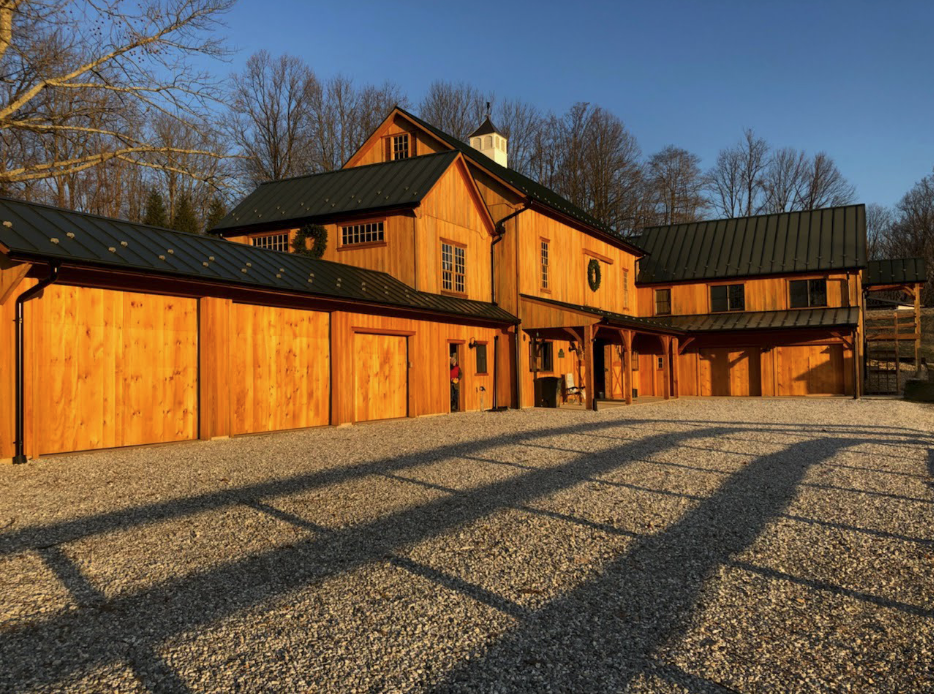
Designing a horse stable is all about creating a space where horses can thrive, and caretakers can manage them with ease.
Whether you’re managing a commercial farm, a residential property, or organizing large equestrian events, the design of your horse stables is critical to the health, safety, and performance of the horses.
In this article, we’ll explore everything you need to know about creating high-quality horse stables, including common elements, challenges, and some unique design ideas to help inspire you. Let’s get started!
The Importance of a Stable Stable
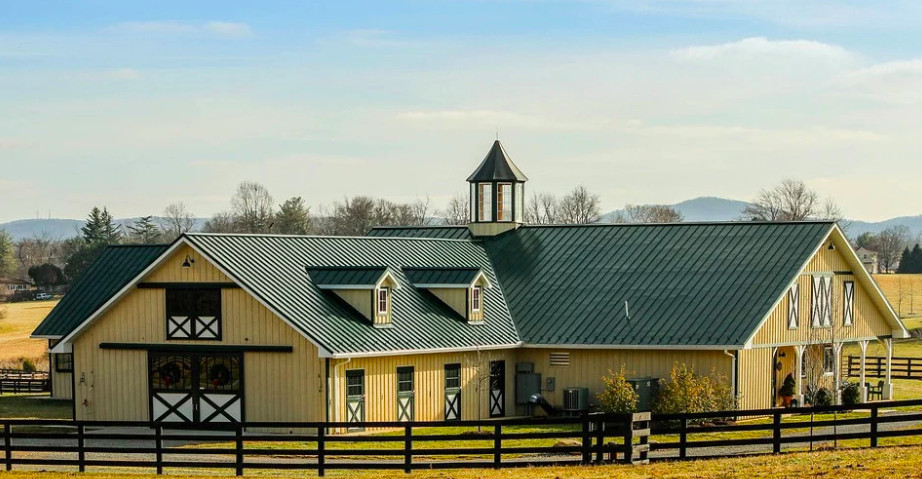
When it comes to horse stable designs, stability is incredibly important. The ground on which horses stand, rest, and move should be firm and secure, preventing unnecessary strain or injury. A stable ground ensures that horses can maintain their health and comfort, reducing the risk of common issues like hoof problems.
Beyond the well-being of the horses, stable and secure flooring enhances the overall functionality of the stable. A firm foundation prevents the buildup of mud and waste, making it easier to clean and maintain. This not only keeps the environment healthy for the horses but also reduces the workload for those who care for them.
The Elements of a High-Quality Horse Stable
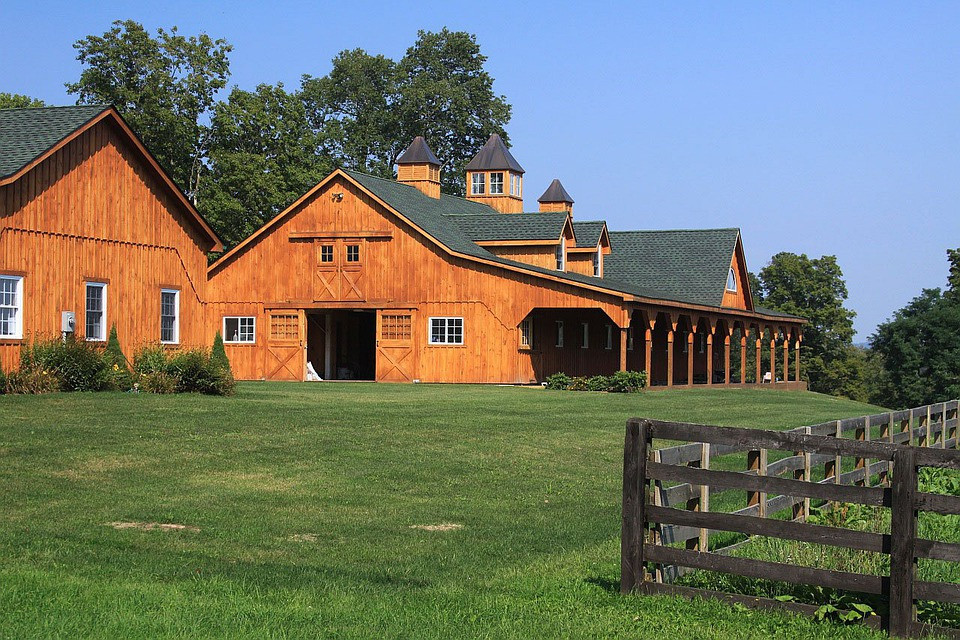
Creating a high-quality horse stable requires attention to several key elements. A well-designed stable should include:
- Durable and Permeable Flooring: High-quality, permeable flooring ensures stability, reduces mud, and provides proper drainage.
- Ventilation: The best horse stables promote airflow to keep the environment fresh and free from harmful bacteria.
- Safety Features: If you want to create a high-quality horse stable, you should include proper lighting, secure doors, and safe stall dividers.
- Comfortable Stalls: Think about how you’d feel if you were a horse. That’s why you should always provide ample space for horses to move freely and lie down comfortably.
- Easy Maintenance: As a horse caretaker, your goal is to make things as easy as possible on your horse and yourself, so you should prioritize materials and layouts that simplify cleaning and upkeep.
- Efficient Layout: Your layout should be simple and efficient and should promote easy movement for both horses and handlers.
The Typical Challenges that Horse Owners Face with Stable Design

Designing horse stables comes with its own set of challenges.
One of the most common issues is managing drainage. Poor drainage can lead to muddy, unsanitary conditions that are uncomfortable and unhealthy for horses. Another challenge is maintaining a balance between ventilation and warmth, ensuring that the stable is airy but not drafty, especially in colder climates.

Space constraints can also be a significant challenge, particularly for those with smaller properties. Ensuring that each horse has enough room to move and rest comfortably without compromising on the number of stalls requires careful planning.
Fortunately, there are easy-to-install products like permeable pavers from TrueGrid and other durable, eco-friendly materials that make these challenges much easier to overcome.
6 High-Quality Horse Stable Designs with Permeable Pavers
When it comes to horse stables design, there is a nearly endless array of options at your disposal. Here are six high-quality horse stable ideas featuring permeable pavers to inspire your next project.
1. Open-Air Stables
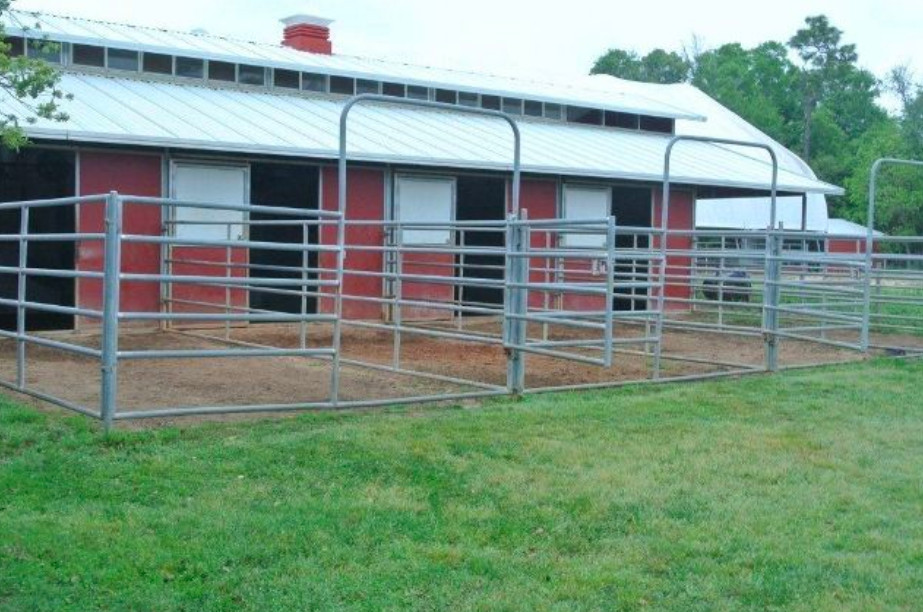
An open-air stable design benefits greatly from permeable paver aisles. Our pavers provide excellent drainage, ensuring that rainwater and runoff do not accumulate, keeping the aisles dry and safe for both horses and handlers.
2. Large Stalls with Permeable Floors
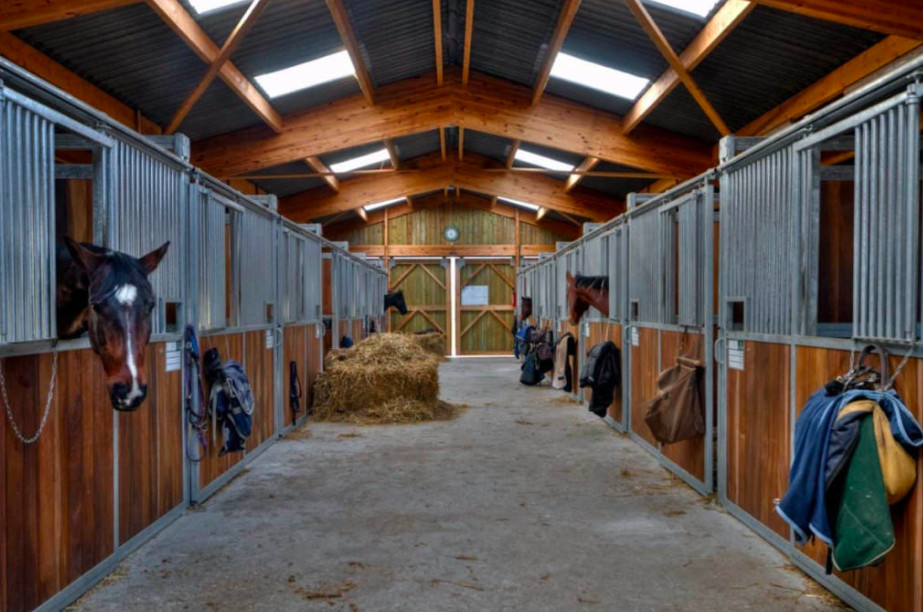
Incorporate permeable pavers directly into the stall flooring for a stable that prioritizes the comfort and health of your horses. These pavers offer a firm yet forgiving surface, reducing stress on the horses’ joints and hooves.
3. A Central Courtyard
For a more communal horse stable design, consider a central courtyard with permeable paver paths connecting the various stalls and facilities. This design not only looks aesthetically pleasing but also provides a practical solution to mud and water buildup.
4. Permeable Wash Racks
A wash rack is an essential part of any horse stable, and using permeable pavers as the base can make it even more effective. Our pavers allow water to drain away quickly, preventing standing water and reducing the risk of slips and falls.
5. A New and Improved Paddock

Design a stable horse paddock where horses can exercise and socialize, using permeable pavers as the base. This design helps maintain a clean exercise, preventing erosion and keeping the space well-defined. Permeable grid pavers will drain, provide extreme support, and reduce maintenance.
6. Driveway and Parking Areas
If you have a large property with lots of stables, why not focus some time and attention on your parking area? Permeable parking areas with TrueGrid permeable pavers not only provide a stable and durable surface for vehicles but also help manage stormwater runoff, reducing the impact on surrounding landscapes, including the horse stables.
Design Your Horse Stable with Permeable Pavers from TrueGrid

Designing a horse stable that meets all the necessary requirements can be daunting, but with TrueGrid’s permeable paver solutions, you can ensure that your stable is not only functional but also sustainable.
Our pavers provide a stable, mud-free environment that promotes the health and well-being of your horses while simultaneously making maintenance a breeze.
Check out our Project Gallery to see more examples of how permeable pavers can be used to transform your horse stables. Contact us today to learn more!
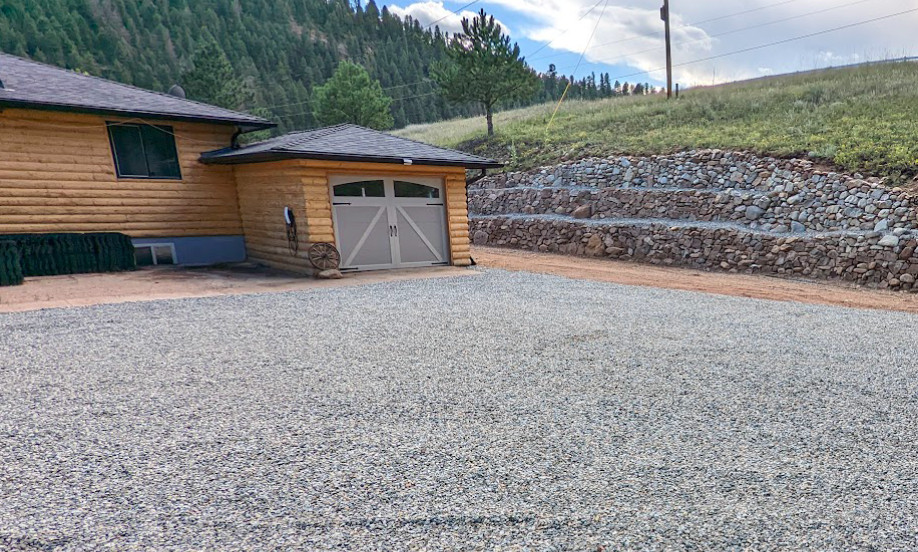
Are you thinking about installing a DIY gravel driveway on your property? If so, keep in mind that you can create a durable and attractive driveway without breaking the bank.
Here’s what you need to know about DIY gravel driveways, including how to install them.
(We’ll even talk about a DIY gravel driveway alternative at the end.)
Are you ready to get started?
Let’s jump in!
DIY Gravel Driveways
A DIY gravel driveway is a popular choice for homeowners who are looking for a cost-effective driveway solution.
These driveways consist of multiple layers of gravel, which create a solid and permeable surface that can handle the weight of vehicles and allow water to drain away naturally.
How Much Do DIY Gravel Driveways Cost?
One of the biggest advantages of DIY driveway gravel is its cost-effectiveness.
On average, gravel costs about $1–$3 per square foot, which makes it one of the most affordable driveway materials on the market.
That said, costs can vary based on the type of gravel you choose and the region you’re in. And don’t forget to factor in any other potential expenses, such as tools, edging materials, and equipment rentals.
But overall, a gravel driveway DIY is a budget-friendly option.
The Challenges of DIY Gravel Driveway Drainage
However, although DIY gravel driveways are affordable, there are several challenges that come with them, including:
Proper Drainage
Without proper drainage, water can pool on your driveway and cause erosion, potholes, and a generally uneven surface. DIY gravel driveway requires careful planning for the drainage to flow effectively.
Driveway Edges
It’s also easy to overlook the importance of driveway edging. However, without a proper DIY gravel driveway, your gravel could start to spread into your yard, leading to an unsightly mess.
A Step-by-Step Guide on How to Install a DIY Gravel Driveway
Before you start installing your DIY gravel driveway, let’s walk through the steps you’ll need to follow to build a gravel driveway that stands the test of time.
1. Measure Your Driveway
Begin by measuring your driveway area. This will help you determine how much gravel and edging material you’ll need. Be sure to account for any curves or unusual shapes.
2. Purchase Your Gravel
Select your gravel based on your driveway’s needs. But you will typically need three layers:
- Base layer of larger stones (or road base in some cases)
- Top layer of gravel
Quick Tip: Order slightly more than you think you’ll need to account for settling.
3. Gather Your Tools and Supplies
Ensure you have all the necessary tools and materials before starting. This includes a shovel, a wheelbarrow, a rake, gloves, a compactor—and more! Also, don’t forget your edging materials and any drainage components you’ve decided to use.
4. Mark the Driveway Boundaries
Use wooden stakes and string to mark the boundaries of your driveway. This will help you visualize the final product and keep your edges straight as you work.
5. Excavate the Driveway Base
Dig out the topsoil and any soft spots along your marked boundaries to a depth of about 6-8 inches. This excavation creates a solid foundation for your gravel layers.
6. Install the Driveway Edging and Additional Drainage (if needed)
Place your edging material along the boundaries of your driveway. Be sure to secure it firmly to ensure it will hold up against the pressure of the gravel and any traffic on your driveway. Perforated pipe wrapped in fabric or other pre-fabricated drainage components can be place to provide an escape for water from low spots or poor draining soils.
7. Install a Landscape Fabric for Weed Prevention
Lay down a membrane over the excavated area to prevent unsightly weeds from growing through your gravel. This step is absolutely important for maintaining a clean and low-maintenance DIY gravel driveway.
8. Spread and Compact the Base Layer
Start with your largest stones, spreading them evenly across the entire driveway area, and use a compactor to press the stones firmly into place. This may require compacting several time in lifts.
9. Spread and Compact the Top Layer
Finally, spread your top layer of fine gravel across the driveway. Compact this layer as well to create a smooth, finished surface that’s ready for use.
Looking for Something More Stable?
If you’re concerned about the long-term stability of your DIY gravel driveway, consider combining traditional gravel with TrueGrid permeable pavers.
Our permeable pavers provide a solid framework that locks your gravel in place, which reduces the risk of shifting and erosion.
No more top-dressing or replacing gravel every 2 to 4 years with traditional gravel drive. TrueGrid infill is meant to last and is very, very low maintenance.
Not to mention, our TrueGrid Pro Lite permeable paver system is an excellent choice for residential driveways because it’s both durable and easy to install.
For commercial projects, check out our TrueGrid Pro Plus. And if you’re looking for something that allows grass to grow, check out our TrueGrid® Root® grass paver system or TrueGrid PRO LITE with Grass infill.
Create the Best DIY Gravel Driveway System with TrueGrid Permeable Pavers

Ready to build a driveway that lasts?
By incorporating TrueGrid permeable pavers into your DIY gravel driveway project, you’re setting yourself up for ultimate success.
Not only do these pavers provide superior stability and drainage, but they also make your driveway more eco-friendly by reducing runoff and promoting groundwater recharge and can last 25 years or more.
Check out our project gallery for some DIY design inspiration, and don’t forget to check out our handy installation guide to ensure your project goes smoothly.
Contact us today to learn more!
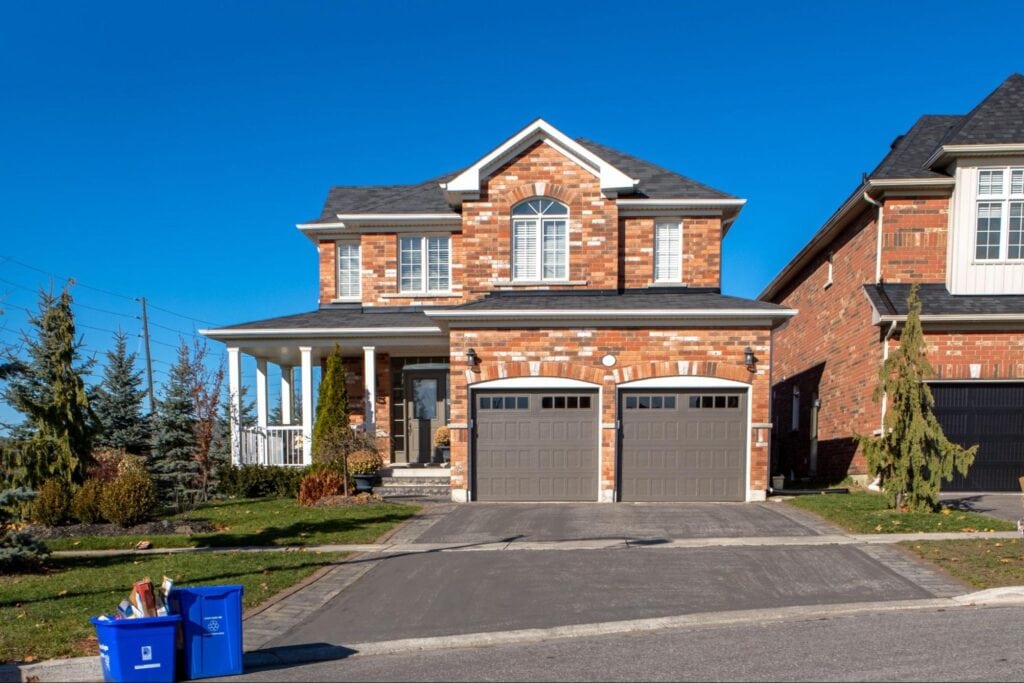
Are you thinking about installing a timber sleeper driveway for your home but aren’t sure if it’s the best option? That’s okay!
Like any driveway material, timber sleeper driveway materials come with their own set of challenges.
Let’s explore what timber sleeper driveways are, how much they cost, a few of their pros and cons, and why you might want to consider permeable pavers as a superior alternative.
Are you ready?
What is a Timber Sleeper Driveway?
A timber sleeper driveway is a driveway that uses large, rectangular wooden beams, commonly known as sleepers.
These sleepers are typically made from hardwood or treated softwood and are laid out in a pattern that creates a rustic, natural-looking driveway. Sometimes, the beams are flush with each other, and other times, they are held in place by compacted sand or gravel.
How Much Do Timber Sleeper Driveways Cost?
The cost of a timber sleeper driveway can vary wildly depending on factors like the type of wood used, the size of the driveway, and the complexity of the installation.
On average, you can expect to pay between $25–$45 per square foot, which typically covers the cost of materials, labor, and any necessary treatments to ensure the wood’s longevity.
However, the initial cost is just one part of the equation. Timber sleeper driveways often require regular maintenance to prevent rot, warping, and insect damage, which can add to your long-term expenses.
The Pros and Cons of Timber Sleeper Driveways
Timber sleeper driveways have their advantages, but they also come with a few significant drawbacks. Here’s what you should know:
The Pros of Timber Sleeper Driveways
Timber sleeper driveways offer a variety of advantages that make them a popular choice for homeowners. For instance:
- Aesthetic Appeal: The natural wood look of timber sleepers adds rustic features that complement traditional and rural home designs.
- Customizable: Timber sleepers can be cut and arranged in various patterns for a customized and personalized design.
- Eco-Friendly: Timber sleeper driveways are an environmentally conscious option that reduces the demand for new lumber, which minimizes waste.
The Cons of Timber Sleeper Driveways
Here are the drawbacks:
- Maintenance: Wood requires regular treatment to prevent rot, warping, and insect damage.This can be expensive.
- Durability: Timber sleepers may not withstand heavy traffic or extreme weather as well as other materials. This can lead to quicker deterioration and the need for more frequent repairs, which can also be costly.
- Cost: Because of the high cost of the materials, the initial installation cost of a timber sleeper driveways can be high.
- Environmental Impact: If you don’t use reclaimed wood, timber harvesting can contribute to deforestation. The chemicals used for wood treatment can have negative effects on the environment.
- Limited Lifespan: Timber sleeper driveways have a shorter lifespan when compared to more durable materials.
Timber Sleeper Driveways vs. TrueGrid Permeable Pavers
When comparing timber sleeper driveways to TrueGrid permeable pavers, it’s clear that while timber sleepers offer a certain charm, TrueGrid pavers provide a more durable and sustainable solution.
Timber sleepers may appeal to homeowners who prioritize a rustic aesthetic above everything else, but our permeable pavers at TrueGrid are designed to last and look beautiful.

Additional Benefits of TrueGrid Permeable Pavers
Our permeable pavers are made from 100% recycled materials, which helps you create an eco-friendly driveway that requires minimal maintenance.
They are engineered to stand up against heavy loads and inclement weather conditions, making them a super reliable choice for any driveway. And they’re just as customizable and aesthetically pleasing as timber sleeper driveways—or more!
Beyond that, our permeable pavers offer excellent permeability that allows rainwater to pass through your driveway and into the ground. The benefit? It reduces ground runoff and helps prevent erosion.
Build a Reliable Driveway with Permeable Pavers from TrueGrid
Choosing the right driveway material is important, and while timber sleeper driveways have their appeal, they may not be the most practical or durable choice in the long run.
TrueGrid permeable pavers are a superior alternative that provides long-lasting performance, low maintenance, and environmental benefits.
Which timber sleeper driveways simply can’t match.
If you’re ready to invest in a driveway that’s built to last, explore our array of permeable paver options, including our TrueGrid® Root® grass pavers and TrueGrid Pro Lite for grass or gravel infill.
Want to learn more?
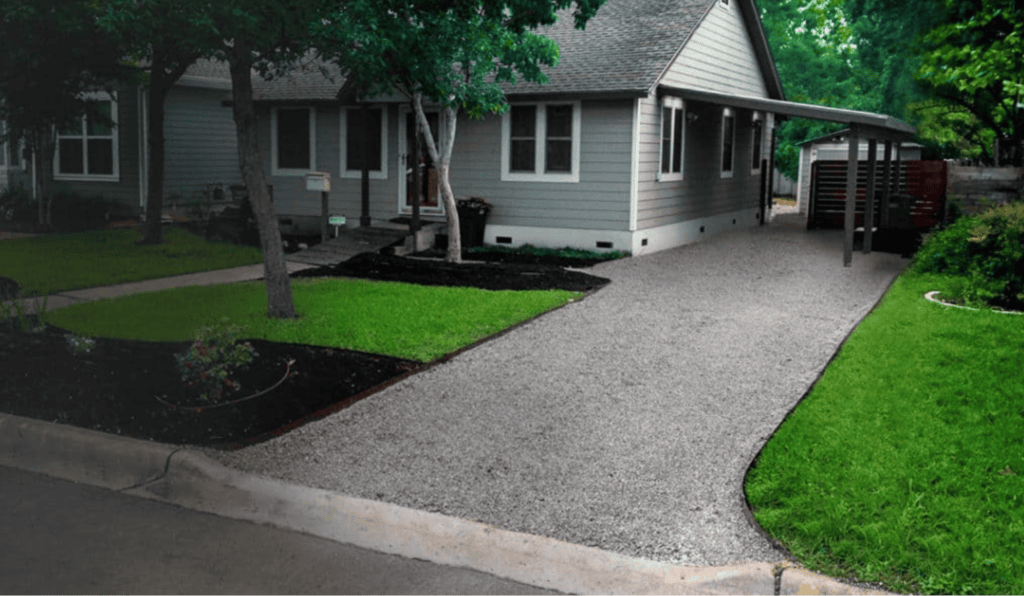
Are you looking for some new and innovative small driveway design ideas? Working with a small space can be tricky, but with the right design ideas, you can transform a compact space into something both functional and stylish. Whether you’re a homeowner looking to maximize your driveway’s potential or a general contractor seeking innovative solutions, these small driveway design ideas are just what you need to get started.
The Challenge of Designing Small Driveways
Driveway design for small spaces comes with its own unique set of challenges. Limited space means you have to think creatively to maximize the functionality of your driveway without sacrificing curb appeal. It’s all about ensuring easy access for your vehicles, proper drainage, and a design that doesn’t distract from the aesthetics of your home’s exterior.
Another challenge is choosing materials that can withstand the demands of a driveway while still looking great in a smaller area. Traditional options like concrete and asphalt can feel overwhelming in small spaces. That’s where permeable pavers come in – they’re the perfect sustainable solution that meets all your small driveway needs.
Introducing TrueGrid Permeable Pavers
Permeable pavers are an excellent choice for small driveways. They offer a ton of important benefits, from improved drainage to reduced maintenance. Unlike traditional driveway materials, permeable pavers allow water to pass through, preventing pooling and minimizing runoff. This makes them particularly suited for small spaces where heavy rainfall and water drainage are often a concern.
TrueGrid permeable pavers even take it a step further. They are durable, easy to install, and incredibly versatile. Plus, they’re environmentally friendly because they’re made from recycled materials. Whether you go with the TrueGrid Root for a more natural grassy look or the TrueGrid Pro Lite for a sleek, modern finish, you can’t go wrong!
9 Design Ideas for Small Driveways
When it comes to designing a small driveway, the possibilities are endless. Here are nine design ideas to help you make the most of your small driveway.
1. Curved Pavers

This driveway design features a curved permeable paver driveway leading to a beautiful home flanked by cobblestone accents. The permeable pavers not only enhance the aesthetic appeal with their natural stone look but also perfectly complement the overall landscape and exterior décor.
2. Heightened Functionality
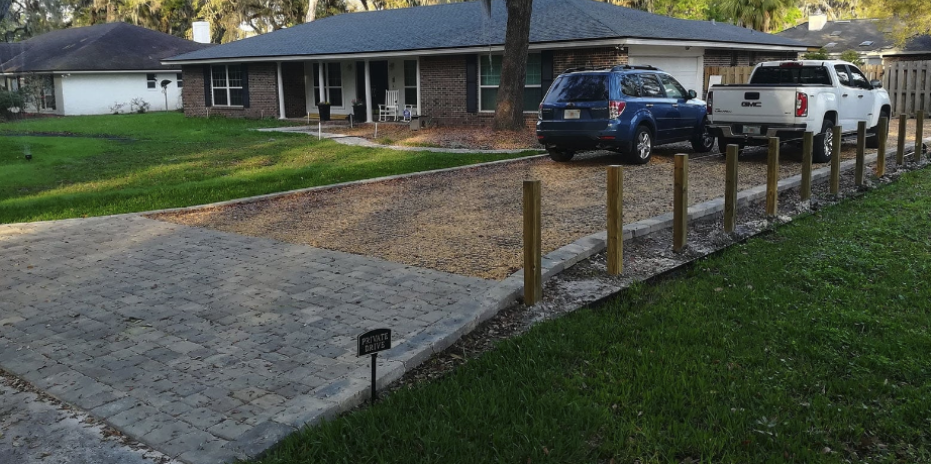
This contemporary small driveway blends permeable pavers with gravel and timber posts to create a durable, reliable, and functional small driveway design. This unique design allows for efficient water management, while the contrasting materials add visual interest. Our permeable pavers make this driveway both eco-friendly and stylish, ensuring a durable, low-maintenance solution that’s perfect for modern homes.
3. The Beauty of Grass Pavers

This compact driveway is cleverly integrated with grass pavers, creating a green oasis right at the entrance of the home. That’s the beauty of grass pavers. They’re the perfect paver for any homeowner who wants to maintain their grass’s health because it allows water to penetrate the ground, ensuring a fresh and vibrant lawn year-round.
4. Gravel Without the Drawbacks

This driveway design combines permeable pavers with traditional gravel to create a gravel driveway that has all the benefits of permeability and none of the drawbacks. The permeable pavers integrate beautifully with the surrounding greenery, providing a sturdy base for vehicles while maintaining the small driveway’s functionality.
5. Grass Pavers with Turn-Around

A grass permeable driveway with an integrated turn-around half circle make for easy parking and plenty of parking for parties and gatherings.Timbers line the edging to separate the supported surface – with the permeable paver – from the unsupported turf. The permeable nature of the grass pavers ensures effective water drainage, keeping the grass nice and healthy.
6. Green, Green, Green!
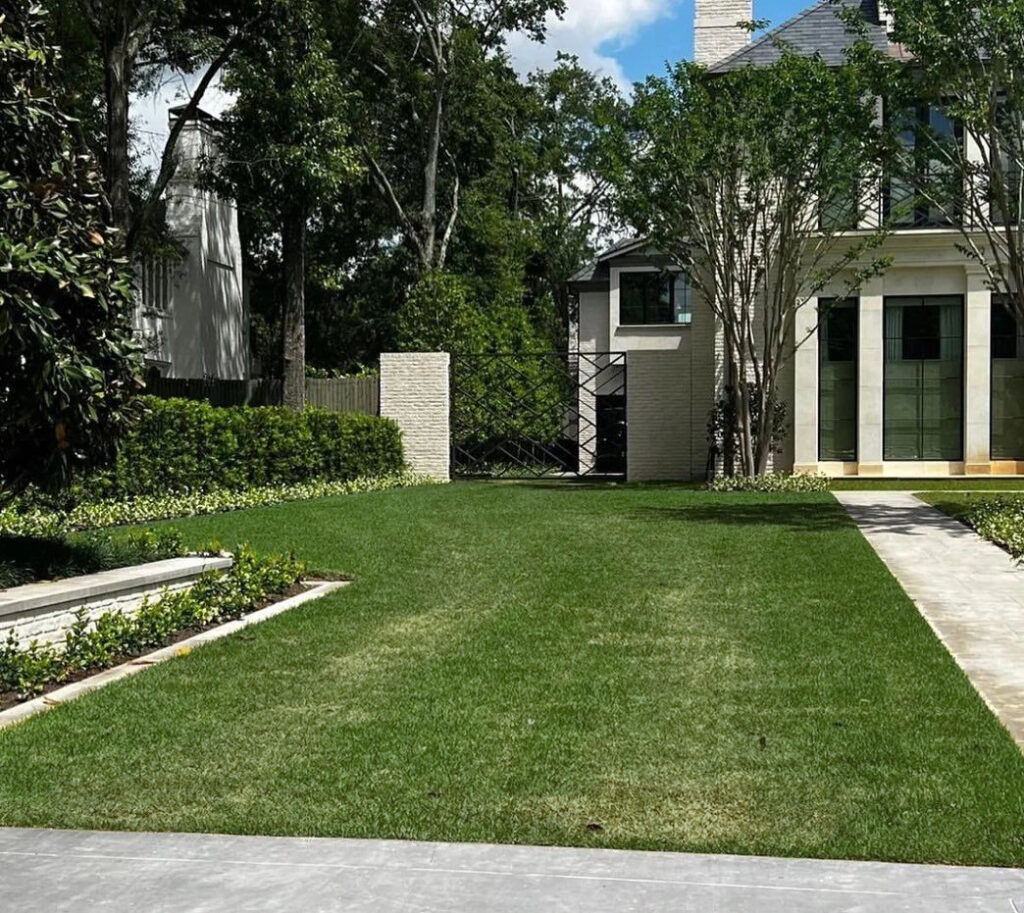
Using permeable grass pavers, this small driveway achieves a lush and green appearance comparable to a well-kept lawn. The pavers provide the necessary strength to support vehicles, while the permeability allows water to seep through, keeping the grassy area nice and green.
7. Intricate Designs
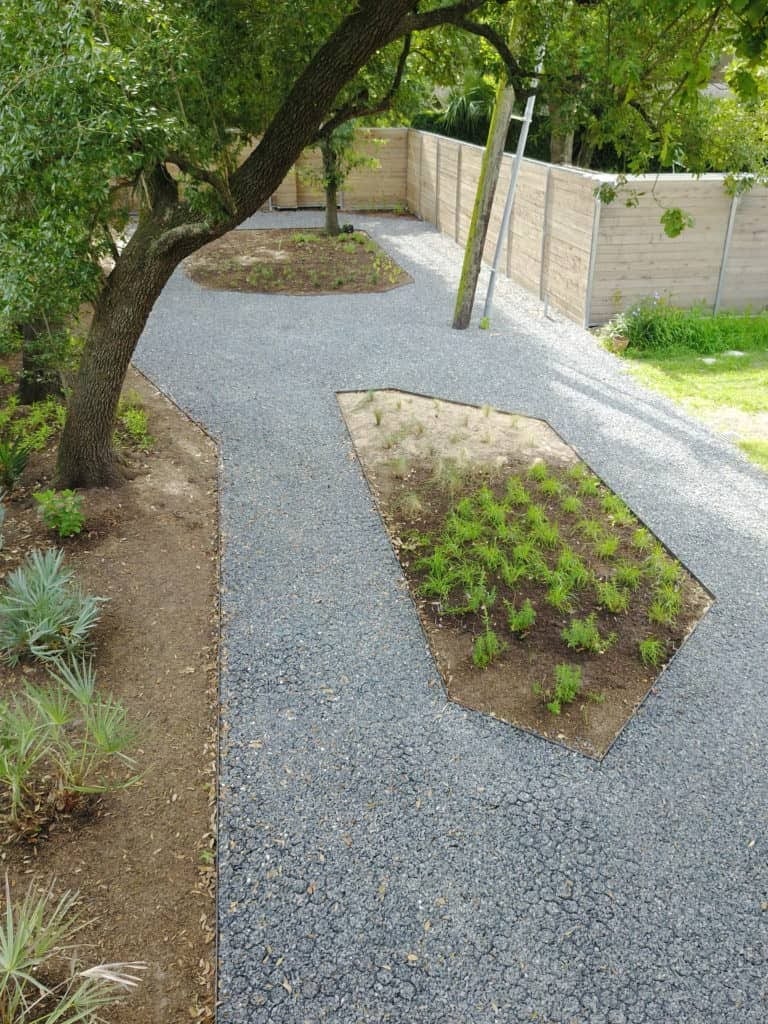
With a winding layout and multiple garden beds, this small driveway idea combines permeable pavers with natural landscaping elements to create an intricate design that any homeowner would love to call their own. The pavers ensure that water is absorbed efficiently, protecting the surrounding plant life while providing a stable surface to drive on.
8. Rustic Farmhouse Driveway

Combining permeable pavers with a gravel surface, this driveway leads up to a charming farmhouse. The use of permeable pavers ensures durability and proper drainage, which is absolutely critical for a space like this.
9. Playing With Textures
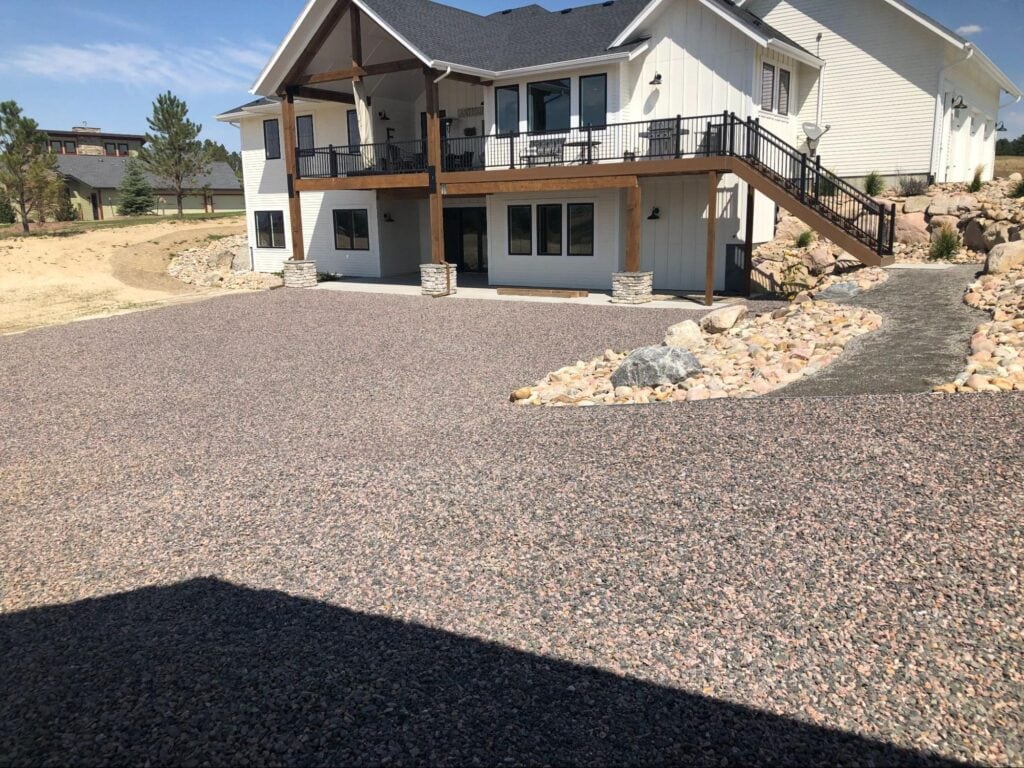
This spacious driveway is made with permeable pavers, offering plenty of room and making the small space appear significantly larger. Using our permeable pavers also allowed the designer of this driveway to play with different natural textures, providing a ton of visual interest that really pulls the home’s exterior décor together.
Design Your Small Driveway with Permeable Pavers from TrueGrid

Are you ready to transform your small driveway into a space that’s both practical and beautiful? Whether you’re looking to create a sleek, modern look or a more natural, rustic feel, our permeable pavers are the ideal product for you.
Explore our product line and let us help you design a driveway that not only fits your space but also enhances the overall aesthetic of your home.

